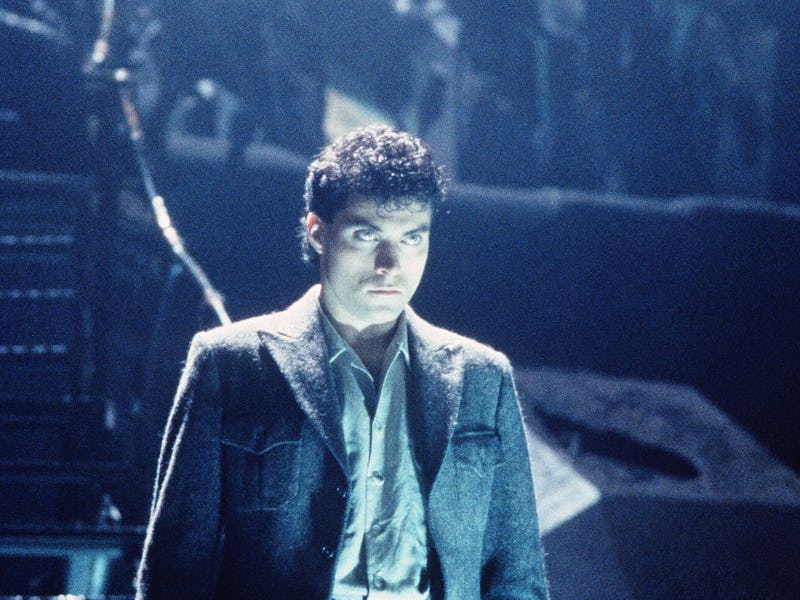Before The Matrix, One Simulation Thriller Fully Embraced Its Noir Origins
With its new 4K Blu-ray release, it’s time to revisit the underrated Dark City.

A man wakes up in a bathtub in a dingy hotel room, next to incriminating evidence of a violent crime he does not remember committing. A phone call instructs him to escape before gaunt, sinister enforcers, dressed in uniform trenchcoats and wide-brimmed hats, capture him. It is night outside — it is always night outside — and our lead character, an amnesiac named John Murdoch (Rufus Sewell) must search for answers in a city with shifting borders and escape the faceless villains using him for their rigid, reality-altering agenda.
Alex Proyas’ Dark City knowingly blurs the distinctions between the genres of “simulated reality” sci-fi and the moral bleakness of the noir thriller. Twenty-seven years on from its initial release (which pales in comparison with The Matrix in the following year) the dazzling sci-fi noir has been rewarded with a 4K upgrade from Arrow Films. The new release honors the scope and vision of a ‘90s gem that understood that paranoid sci-fi and classic noir saw the world in startlingly similar ways.
How Was Dark City Received Upon Release?
Australian Alex Proyas made his first American film in 1994, the supernatural comic book The Crow, which was a financial success despite its tragically troubled production. Proyas incorporated a range of influences into Dark City’s ideas and design — noir, The Twilight Zone, Franz Kafka, historical sufferers of schizophrenia, German expressionism — but the deliberate, withholding mystery plot prompted reshoots that preemptively corrected the anticipated audience confusion. This resulted in a film that over-explains itself from the opening scene, including the identity and intentions of “the Strangers” in voiceover. Proyas’ original vision was restored in a 2008 director’s cut.
Roger Ebert loved the film, and even recorded a commentary track for the 1998 DVD release (which you can listen to on the 4K Blu-ray), but despite sincere praise, the critical response was best characterized by a respect for the vision and craft but befuddlement over the execution. Even though Dark City released months later than Titanic, the epic film showed no sign of slowing down; in its opening weekend, Proyas’ film earned just over a quarter of what James Cameron’s film earned in its tenth. Dark City couldn’t even crack the top hundred highest grossing films at the 1998 box office.
Why Is Dark City Important to See Now?
Dark City’s marriage of paranoid sci-fi and noir was impeccable.
In films that question our reality, the artifice of our characters’ environment is next-to pristine without obvious signs that they’re living in an imagined world. In Dark City, we’re immediately aware that reality is being expressed in a heightened, unrealistic way — if the swaying bare bulbs and murky shadows aren’t enough, Dark City evokes ‘40s crime films with jazz clubs, gruff detectives, and pale-faced G-men framing men for murder. The altered reality (or more accurately, “tuned” reality) is unrealistic in Dark City because Proyas is tapping into the shared tissue between the genres. In noir, what’s wrong with the world is ever-present, hanging like a thick fog of corruption and injustice, often localized within the characters’ psychology. Crucially, it’s a dysfunction that can’t be cured or dispersed within the story — the ability to alter the poisonous reality is out of our reach.
This conscious but ambiguous alienation is exactly how simulation thrillers operate. The suspicion that something beyond your control is affecting our thoughts and agency is an incurable malady when constrained to the scuffed streets and smokey alleys of noir, and Dark City literalizes this mood with sci-fi mechanics — the Strangers psychically change our world to better observe the human condition in the hopes they can extract our knack for longevity and survival, creating conspiracies to cover up the gaps in their altered reality.
Dark City distinguishes itself from The Matrix and The Truman Show — films about questioning the sanctity of our perceived reality that both came out within 13 months of Dark City’s premiere — by merging a historic Hollywood genre with an emerging one. Even as Proyas piles on Gothic horror and paranoid conspiracy to his genre pastiche, Dark City uses science-fiction as a tool to break open the close-ended cynicism of noir into utopic promise. Yes, the story suggests you may need Neo-level psychic powers in order to reshape your punishing environment, but if we think of it metaphoricallY, we simply cannot tell how free we will feel by taking control over our life until we do it.
What New Features Does the Dark City 4K Blu-ray Have?
The new 4K release includes a host of new commentaries and an hour-long documentary.
When it comes to boutique home video labels, Arrow Films is virtually peerless. Dark City is a perfect candidate to receive their thorough and full-bodied physical media upgrade; the Blu-ray contains 4K restorations of the theatrical cut and superior director’s cut, a 60-page collector’s book featuring a plethora of new critical responses, plus a specially commissioned fold-out poster and postcards of the elusive “Shell Beach” that Murdoch chases throughout the story.
If you mourn the ubiquity of commentary tracks on home video, Arrow Films once again has you covered. The 4K includes a range of archived tracks, plus new commentaries from Proyas and the hosts of the Film Versus Film podcast, but you’ll also receive a new visual essay from scholar Alexandra West and a new hour-long documentary diving into the film’s meticulous craft. Even though the film is built on tantalising, noir-soaked mystery, Arrow’s new release answers every Dark City question you might still have.